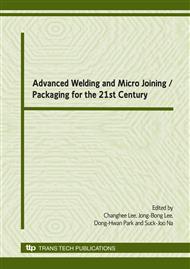p.251
p.259
p.263
p.267
p.271
p.275
p.279
p.283
p.287
Computer Simulation of Wetting and Flowing Behaviors of Filler Metal during Laser Brazing Process
Abstract:
The wetting and flowing behaviors of the filler metal during laser brazing process were analyzed by the computer simulation. Two situations of the wetting and flowing during laser brazing were modelled, i.e., the metled Au-18%Ni and Ag-10%Pd filler metals on the butt joint of Inconel 600, and the melted Cu-8%Sn filler metal on the dissimilar butt joint of type 304 stainless steel to Cu. The filler metal droplet wetted and spread on the base metals and simultaneously infiltrated into the joint gap with the lapse of time. The Au-Ni and Ag-Pd filler metal infiltrated into the 0.3mm wide joint gap at the completion of brazing even in the single beam brazing. The Au-Ni filler metal did not infiltrate into the joint gap completely at the brazing clearances of 0.1-0.2mm in the single beam brazing, however, it could be filled up in the joint gap in the tandem beam brazing. The Cu-Sn filler metal wetted on the both base metals of stainless steel and Cu and filled up the 0.3mm wide joint gap when the location of preheating beam deviated in 0.5mm to Cu substrate, however, it did not infiltrate into the joint gap completely at the deviation distance of preheating beam to Cu substrate being 1.0mm. It followed that the wetting and flowing behaviors of the filler metal during laser brazing process could be predicted by the computer simulation.
Info:
Periodical:
Pages:
271-274
Citation:
Online since:
June 2008
Authors:
Keywords:
Price:
Сopyright:
© 2008 Trans Tech Publications Ltd. All Rights Reserved
Share:
Citation:


